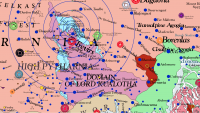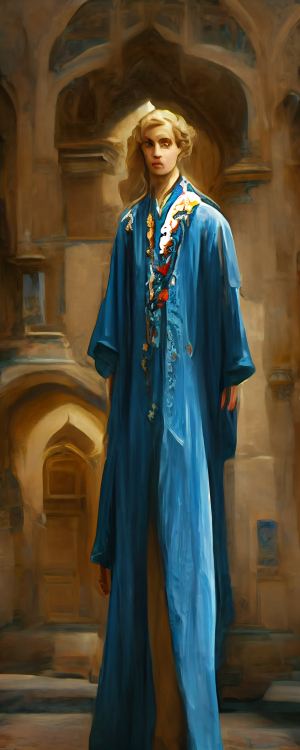Lord Kualotha of the Groaning Earth
![]() b 2238, reigned 2257 to 2311, date or manner of death unknown. According to the most traditional legend, Kualotha was born in Trevirs during an earthquake that brought down the highest towers of the old Arathracian Temple. By his own confession, Lord Kualotha was born an androgyne and blessed of the gods of Chaos. By the statements of his contemporaries, Lord Kualotha was moderate in his tyranny, untypical of Chaos Rulers, but nonetheless indulged in flights of fancy and whimsy. He styled himself "Lord Kualotha, Blessed of the Anarchs and Friend of Many" and often referred to Prince Ulcanov as "my wicked, older brother."[1] One of the few Chaos Rulers who was not actually slain at the conclusion of an Isbajath, Lord Kualotha fled to self-imposed exile in the Great Disdrire Forest where it is believed he passed into another realm through the use of his chaos magic. During his rule, he promoted the study of chaos magic or anything that appeared to teach chaos magic. Trevirs became a center of magical learning, not all of which was chaos magic.
b 2238, reigned 2257 to 2311, date or manner of death unknown. According to the most traditional legend, Kualotha was born in Trevirs during an earthquake that brought down the highest towers of the old Arathracian Temple. By his own confession, Lord Kualotha was born an androgyne and blessed of the gods of Chaos. By the statements of his contemporaries, Lord Kualotha was moderate in his tyranny, untypical of Chaos Rulers, but nonetheless indulged in flights of fancy and whimsy. He styled himself "Lord Kualotha, Blessed of the Anarchs and Friend of Many" and often referred to Prince Ulcanov as "my wicked, older brother."[1] One of the few Chaos Rulers who was not actually slain at the conclusion of an Isbajath, Lord Kualotha fled to self-imposed exile in the Great Disdrire Forest where it is believed he passed into another realm through the use of his chaos magic. During his rule, he promoted the study of chaos magic or anything that appeared to teach chaos magic. Trevirs became a center of magical learning, not all of which was chaos magic.
Epithet of the Groaning Earth
He earned the epithet "of the Groaning Earth" for the dull groaning that indeed accompanied him wherever he walked. He held the powers of earth in great esteem and many of his magics drew from the earth below him. He caused earthquakes through his magics on several documented occasions to protect the city of Trevirs from invading hordes out of the Jaggudorns. Such quakes would level farmhouses and manors in the hills of High Pytharnia without so much as knocking a teacup out of the cabinet in the city of Trevirs. Citizens and visitors to Trevirs would utter in hushed tones, "The earth groans under her weight" and such groaning signaled his advent.
Appearance and Androgyny
Lord Kualotha was a tall and slender human with long, flowing blond hair and green eyes that became deeper and more gem-like through his life. His features were thought the best of both male and female genders and he was considered handsome or beautiful depending upon the observer's perspective. He preferred dressing in men's clothing, albeit with loud colors and much flair, stating that "my mother raised me to be a man, so why disappoint her?" Despite his claims of natural androgyny, many detractors spread the belief that he became male and female through the use of his magics, claiming that his birth gender was in fact male. He rarely took issue with this wide-spread belief which further fed its credibility, although his defenders say this was due to his generous nature. His worship of the Chaos God Errignomon was at the source of many of these rumors. On days he considered holidays, he would dispense with clothing altogether, saying his robes were on holiday. His courtiers and ministers tended to refer to him in the male gender, but there were many exceptions.

Ascent to Power
Kualotha became a member of the Flaminal College during its last period of rule over Trevirs. He rose in influence and prestige in the college and ultimately compelled them to make him pre-eminent among their number. Over the early part of the next fifty four years of his dominance, relatively short compared to other Chaos Rulers of the age, Kualotha became the de facto ruler of Trevirs and the Flaminal College became a body under his sole power.
Leadership
In addition to sponsoring the study of magic and the wizards' council of Trevirs, Kualotha led several successful campaigns against the Jaggudorns and the chaos rulers of Medibgö, including Ddägduch Lord of the Flying Earth, compelling the latter to sue for peace. His seemingly limitless ability to bring about earthquakes was cause enough for the dwarves of the Jaggudorns and the Ithrads to lavish gifts upon the Chaos Ruler of Trevirs. The desire for and spoiling of this rich treasure at the conclusion of the Twelfth Isbajath tarnished the reputation of the tisbajuma.
Flight into the Disdrire
It became clear to Kualotha with the warriors of the Twelfth Isbajath en route to High Pytharnia that he would probably be destroyed as Prince Ulcanov and other Chaos Rulers had suffered a merciless death in defeat. In the year 2311 AI, Lord Kualotha abdicated his power to the council of wizards and fled to the north into the Great Disdrire Forest where he lived for many years. According to the accounts of his servants, when he no longer could endure his life, he invoked great magics of chaos and vanished into another realm of existence.
Legacy
Kualotha is held in mixed remembrance in the minds and hearts of the inhabitants of High Pytharnia. When petitioned about the droves of orphans running through the streets of the Trevirite ghettoes, he ordered them gathered up to live in his palace for several weeks. After a month of enduring Lord Kualotha's largesse and bizarre eccentricity, the orphans fled to the countryside in search of farm labor. Many of today's children's stories are said to come from the actual accounts of the orphans after they left the palace and they are popular not only in High Pytharnia but in many other lands. The book Tales of Old Pytharny compiled in the century following Lord Kualotha preserves many of them. [2] The idiom "It's not over until Lord Kualotha dances," is thought to derive from this book.
A less amusing episode recounts that Lord Kualotha once flooded his palace with magical, therapeutic mud so that his servants could enjoy a good cleaning as well as him. An aristocrat complained mirthfully to him that he had drowned several of the palace staff to which Lord Kualotha replied, "They would never have been buried so splendidly had they lived."
The immense treasure which Kualotha had acquired during his long reign was horded by the tis'bajuma as the legacy of the people of Magdala. Despite this, several artifacts and some funds were lost, tarnishing the reputation of the tis'bajuma. With the re-establishment of lawful Magdala, the treasure came under the stewardship of the Emperor of Magdala. Subsequently, some of the gold was used in the early twenty sixth century by Emperor Talban II to gild the column capitals and roof tiles of the Temple of Amrulon Sun God (Amyrn).
Biography
His life and rule are chronicled in the book Five Lives of the Princes of Chaos by Amric Ethuve who drew from sources contemporary to Lord Kualotha, including Tales of Old Pytharny.[3]
References
Sources
 Primary Sources
Primary Sources
 Secondary Sources
Secondary Sources
- Five Lives of the Princes of Chaos, 2579, Amric Ethuve
- God's Whirlwind: The Isbajutha, 2568, Thulinantis Tepriax of Zamaclë
- Tales of Old Pytharny, 2555, Aliskémon Tharstros
See Also
- Aliskémon Tharstros
- Amric Ethuve
- Barystonian Period
- Chaos
- Chaos Gods
- List of Greater Chaos Rulers of the Middle Ages
- List of the Rulers of Magdala
- Errignomon
- Five Lives of the Princes of Chaos
- High Pytharnia
- Tales of Old Pytharny
- Trevirs
- Twelfth Isbajath
| This article is a stub. It requires further development by the creator. |
